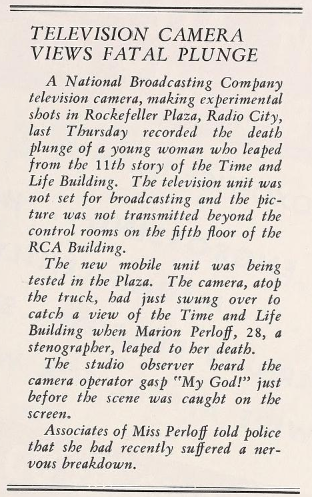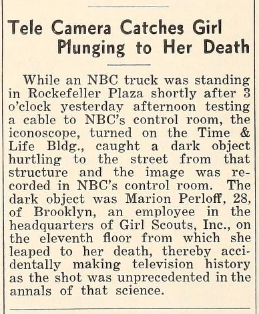Marion Perloff (lost footage of televised suicide of stenographer; 1938)
2nd July 1938 issue of Motion Picture Herald reporting on the television camera capturing the suicide
Status: Lost
On 23rd June 1938, 28-year-old Marion Perloff, a stenographer and clerk working for Girl Scouts, Inc., committed suicide by jumping off the eleventh floor of New York's Time and Life Building. The tragedy made an infamous moment of television history, as it was the first suicide to be captured by a television camera.
Background
Marion Perloff was a stenographer and clerk working for Girl Scouts, Inc., whose office was located on the eleventh floor of the Time and Life Building in Rockefeller Center's Plaza.[1][2][3] A Brooklyn resident, her colleagues claim that, in the three weeks leading up to her death, Perloff had suffered a nervous breakdown triggered by a man rejecting her marriage proposal at the last moment.[2][1] Resulting from this, Perloff was forced to take a vacation to reduce her stress levels.[1][2] A week before her death, she had returned to work.[1][2] However, on 23rd June 1938, colleagues reported she entered the office in a significantly anxious state.[2] To try and calm Perloff, some workers invited her to a work picnic at Scarborough.[2] However, Perloff insisted she needed to phone her sister, Irving Sibushnick, retreating to the toilets to do so.[2] Some female colleagues then began searching for Perloff, as she had suddenly vanished just before the buses for the picnic were set to depart.[2] What they had yet to realise was Perloff had made the decision to end her own life by jumping out of the office's window, aged 28.[2][1][3]
Meanwhile, NBC was conducting outside tests for its fledgling television service.[4][5][6][7][1][2][3] At the time, NBC was off-air, with the tests being directed by NBC's Chief Engineer, O. B. Hanson and others who were viewing footage at the fifth floor of the RCA Building.[1][2][4][3][6][7] Iconoscope Cameraman Ross Plaisted was harnessing a brand new mobile unit, capturing footage and audio across Radio City, including the Time and Life Building.[1][2][4][3][7] At some point prior to 3:30 pm, Hanson directed Plaisted to capture the front of the RCA Building.[1][2] As Plaisted turned the camera, he spotted the distressing sight of Perloff about to jump from the Time and Life Building.[4][5][1][2][3][7] Witnessing her jump, a shocked Plaisted uttered "My God!", before directing the camera to the woman falling from the sixth floor onwards.[4][1][2][6][3][7] Hanson et al were momentarily distracted from the screen, but all suddenly heard a loud thud as Perloff hit the ground, causing all to stare at the monitor in stunned silence.[4][1][2][3][6] Plaisted continued filming, as a large crowd of around 2,000 formed and police tried to reach the incident.[1][2] In a gap in the crowd, the engineers witnessed the body of Perloff on the ground.[1][2]
In an interview with the press, Plaisted explained what he and the engineers witnessed, stating "When I turned my camera toward the Time and Life building, I saw a falling body. My camera picked her up as she passed the sixth floor and I followed her down."[1] Hanson noted "The first we knew that anything had happened, was when we heard a sound like a pistol shot. Turning to the screen we could see people running and before they had crowded around the body we could get a glimpse of it as it lay on the pavement."[1] Perloff's suicide was the first to ever be captured by television cameras, although it ultimately did not publicly air.[1][3][5][4][6][7] However, radio and print outlets, in an attempt to stop television's growth, began spreading a moral panic concerning television potentially capturing other controversial and tasteless incidents.[7][6]
Availability
No photos nor footage of Perloff's suicide are known to have survived. Like with many other earlier television broadcasts, coverage of the suicide was captured live and was not recorded. In fact, the process of recording television transmissions did not regularly occur until videotape was perfected in the late-1950s.[8] Therefore, televised footage of the suicide is most likely permanently missing. Even if it was recorded, NBC likely would not have publicly released the footage out of respect for Perloff and her relatives.
Gallery
Image
References
- ↑ 1.00 1.01 1.02 1.03 1.04 1.05 1.06 1.07 1.08 1.09 1.10 1.11 1.12 1.13 1.14 1.15 1.16 24th June 1938 issue of St. Petersburg Times providing an extensive report into the filming of the suicide. Retrieved 18th Dec '22
- ↑ 2.00 2.01 2.02 2.03 2.04 2.05 2.06 2.07 2.08 2.09 2.10 2.11 2.12 2.13 2.14 2.15 2.16 2.17 24th June 1938 issue of Daily News from New York reporting on the suicide and it being televised. Retrieved 18th Dec '22
- ↑ 3.0 3.1 3.2 3.3 3.4 3.5 3.6 3.7 3.8 Time reporting on the suicide and its television significance. Retrieved 18th Dec '22
- ↑ 4.0 4.1 4.2 4.3 4.4 4.5 4.6 2nd July 1938 issue of Motion Picture Herald reporting on the television camera capturing the suicide. Retrieved 18th Dec '22
- ↑ 5.0 5.1 5.2 24th June 1938 issue of The Film Daily reporting on a television camera accidentally capturing footage of the suicide. Retrieved 18th Dec '22
- ↑ 6.0 6.1 6.2 6.3 6.4 6.5 Gizmodo summarising the suicide and the footage captured by the television camera. Retrieved 18th Dec '22
- ↑ 7.0 7.1 7.2 7.3 7.4 7.5 7.6 The Mammoth Book of Weird Records stating Perloff's suicide was the first to be captured on camera. Retrieved 18th Dec '22
- ↑ Web Archive article discussing how most early television is missing due to the lack of directly recording television. Retrieved 18th Dec '22


